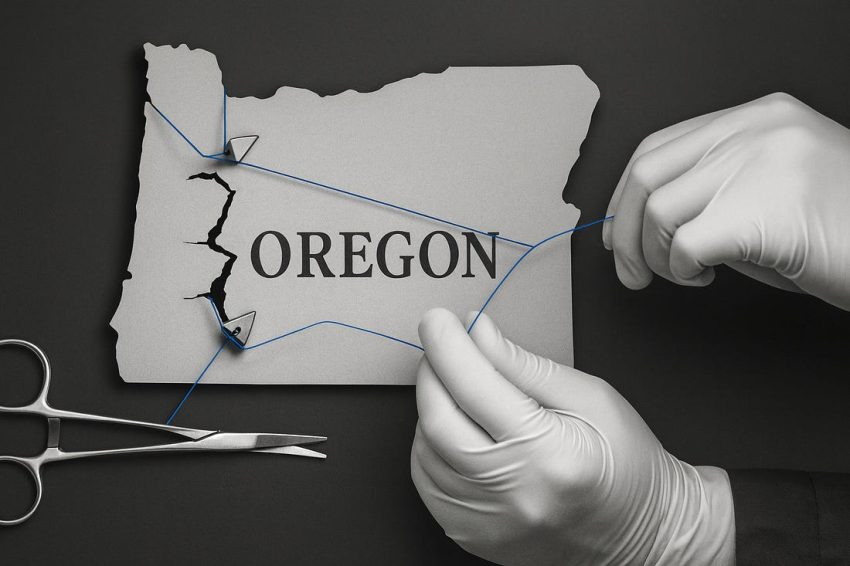EDITOR’S NOTE: Here’s an installment from Tillamook County’s State Representative Cyrus Javadi’s Substack blog, “A Point of Personal Privilege.” Oregon legislator and local dentist. Representing District 32, a focus on practical policies and community well-being. This space offers insights on state issues, reflections on leadership, and stories from the Oregon coast, fostering thoughtful dialogue. Posted on Substack, 10/16/25
By State Representative Cyrus Javadi
Because Ignoring the Problem Isn’t an Option
If you’re like me (and like most people), you want good information so you can actually understand the problem before trying to solve it. Too often, politicians give us only part of the story. They show us just enough data to make a point, then lead us toward a conclusion that conveniently fits their agenda.
Like a magician on a cruise ship, they let you see and hear just what they want, and your brain fills in the rest. The illusion works because you assume you’ve seen the whole thing.
But politics isn’t magic. Or at least, it shouldn’t be.
We deserve the raw data. The whole picture, both sides of the story. Because even with all the facts laid out, these issues are still going to be hard to solve.
And if they’re hard with the truth, imagine how impossible they are without it.
So, this week’s article (and next week’s) is about giving you that truth. My hope is not to give you a partisan version of it. Just the tools and context to help you draw your own conclusions, or at least ask better questions.
We’ll start with a controversy: Do undocumented immigrants receive healthcare benefits?
The short answer is yes, but with an asterisk.
The Basics: What “Healthier Oregon” Actually Is
In 2023, Oregon quietly did something different than most states: it extended state-funded health coverage to every low-income resident who meets income and residency requirements, regardless of immigration status.
Now, before anyone reaches for the pitchforks about “handouts,” it’s worth remembering this isn’t a new benefit so much as a new way of paying for what’s already happening.
The program is called Healthier Oregon, and it lives under the umbrella of the Oregon Health Plan (OHP). It’s not a special or separate system; it’s the same comprehensive healthcare coverage that other OHP members receive. It includes doctor visits, prescriptions, behavioral health, dental, hospital care, and preventive services.
It’s the product of a years-long policy evolution.
- In 2017, Oregon expanded coverage to children regardless of immigration status.
- In 2021, the state added young adults.
- By July 2023, the final step, covering adults of all ages, was complete.
The basic eligibility rules are straightforward: Oregon residency, income under 138% of the federal poverty level, and no eligibility for federally funded Medicaid. That last part is important. Because while the benefits look the same, the funding doesn’t. The federal government won’t match the dollars spent on undocumented residents, so Oregon pays for it directly out of the state budget.
Why the State Did It
This wasn’t an act of charity. It was an act of math.
You don’t have to like the policy to see the math. Hospitals can’t legally turn people away in an emergency. That means the state was already paying, just through the back door of higher hospital costs and insurance premiums. Healthier Oregon simply moves that spending to the front door, where we can track it and hold it accountable.
Hospitals were already caring for these patients. Only they were doing it the hard way, through emergency departments and uncompensated charity care. Oregon taxpayers were already paying for these visits; the costs were just buried in hospital budgets and insurance premiums.
Healthier Oregon moved that spending upstream, from crisis care to preventive care.
It’s a fiscal strategy as much as a moral one. You don’t need to be a bleeding heart to see that it’s cheaper to pay for a flu shot than an ICU stay.
And it’s not a small population.
Immigrants, many of whom lack access to employer-sponsored coverage, make up a significant share of Oregon’s workforce in agriculture, food processing, construction, and caregiving. They’re the people keeping the lights on, the shelves stocked, and the crops harvested. When they can’t afford to get sick, Oregon’s entire economy catches a cold.
The Federal Contrast
While Oregon was figuring out how to cover more people, Washington, D.C. was figuring out how to cover fewer.
The federal law, H.R. 1 (aka The One Big Beautiful Bill), passed this year created new work requirements for Medicaid, cut emergency coverage for noncitizens, and reduced the federal match rate for states that try to fill the gap.
In other words, it made it harder for states to help the very populations already at the margins. And, in response, Oregon went the other direction. It built a state-funded bridge where the federal government had left a hole.
That’s not defiance, it’s triage.
If your neighbor’s roof collapses and you patch it with your own lumber, it doesn’t mean you hate your homeowner’s association. It just means you weren’t willing to wait for the next committee meeting.
Who It Helps
If you’ve eaten an Oregon strawberry or stayed at a coastal motel, you’ve likely benefited from the labor of someone who qualifies for Healthier Oregon.
Many are long-term residents with families. Most pay taxes through payroll withholding or ITIN filings. Their kids, often U.S. citizens, were already covered under OHP. The parents simply weren’t. The state decided that didn’t make sense.
They’re not freeloading; they’re part of the workforce that keeps Oregon functioning. They already pay into the system, it’s just that, until now, they couldn’t use the system they help fund.
And yes, some of them are undocumented. But “undocumented” doesn’t mean “unaccounted for.” These are people who live, work, and contribute here, and who, until now, were locked out of the very healthcare system they helped fund.
The Moral and Practical Case
You can debate immigration policy all day, but viruses don’t check immigration papers. Neither do car crashes, pregnancies, or cancers.
Healthier Oregon doesn’t erase the immigration debate; it sidesteps it long enough to deal with reality.
The policy recognizes a simple truth: people who live in Oregon will seek care in Oregon. The only question is whether that care happens in a clinic or an emergency room, and who pays for it.
Every sheriff, hospital CFO, and county commissioner in Oregon already knows these costs exist. The only honest question is whether we pay the bill up front or after the fact and with interest.
From a fiscal standpoint, predictable coverage beats unpredictable crises. From a moral one, it keeps the healthcare system tethered to the idea that all human life has value, even when the paperwork lags behind.
The Politics of Pragmatism
Some critics call this program a magnet for illegal immigration. Others say it’s a moral necessity.
The truth is less dramatic: it’s a state doing what Congress refuses to.
Oregon’s decision didn’t open the borders. It opened a clinic door. And while Washington D.C. debates ideology, Oregon, like a growing number of states, is managing consequences.
This isn’t an invitation to break immigration law. It’s a way of keeping the emergency room open while Congress argues about how to fix the plumbing.
It’s also not a “magnet” for illegal immigration, most people who cross the border are chasing work, not wellness checks. Oregon can’t control federal immigration policy, but it can keep its hospitals solvent and its workforce healthy.
The irony is that Healthier Oregon is both compassionate and conservative. It favors local control, cost predictability, and stable hospitals. It also reinforces personal responsibility: once you’re enrolled, you’re expected to use preventive care, maintain your coverage, and avoid costly emergencies.
In other words, it’s not a radical idea. It’s just a reasonable one.
What’s the Alternative?
If not this, then what?
We could go back to pretending these costs don’t exist, letting hospitals eat them, raising premiums for everyone else, and calling it “fiscal discipline.” But that’s not savings. That’s just denial.
Critics sometimes say, “Just fix immigration first.” I agree, that would be ideal. But waiting for Congress to fix anything right now is like waiting for dial-up internet to load a movie. Until Washington gets its act together, states still have to balance budgets and keep hospitals open.
Or we could build what Oregon built: a pragmatic patch that keeps the system functioning until the country decides what to do about the larger mess. It might not be utopia, but it is triage. And triage gives us time, even if it still comes with costs.
And maybe that’s the real case for programs like Healthier Oregon. They don’t solve everything, but they do keep reality from collapsing while Washington D.C. argues about ideology and shutdowns.
Some will still call this socialism or sanctuary politics. Fine. Maybe. But it’s well accepted that capitalism doesn’t solve every problem well. And look at the balance sheet. Healthier Oregon doesn’t erase immigration law, it just keeps Oregon from drowning in the costs of Washington’s failures. You don’t have to like it to admit it’s rational governance.
Next Week: The Bigger Story
The real question isn’t whether Oregon should have done this. It’s why it had to.
Next week, we’ll trace the immigration story back to its roots, the outdated federal quota system, the impossible wait times, the political gridlock, and the way each failure trickles down to states like Oregon.
Because before we can argue about solutions, we have to understand how the illusion was built; and how for decades, politicians have shown us only part of the picture, convinced us the trick was simple, and left the hard realities to the states.
And maybe, just maybe, by the end of this two-part series, we’ll have a clearer picture of what a sane, humane, and honest immigration policy could or should look like.
If you like commentary that values reality over rhetoric, and you prefer your policy arguments with a pulse and a spreadsheet, subscribe here. Because someone has to keep talking about what actually works while everyone else is arguing about whose fault it is.


